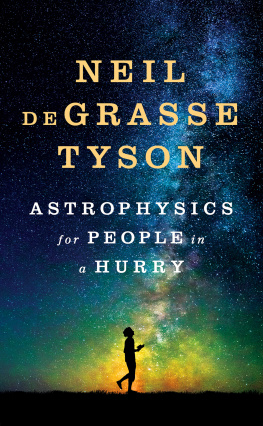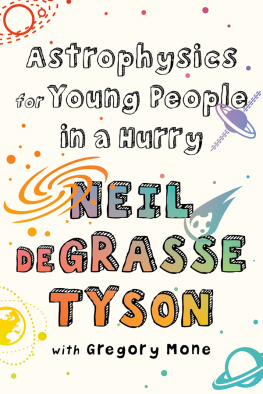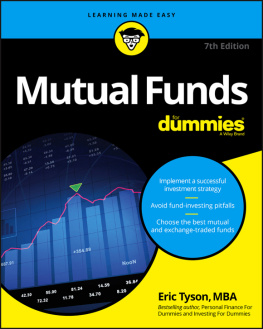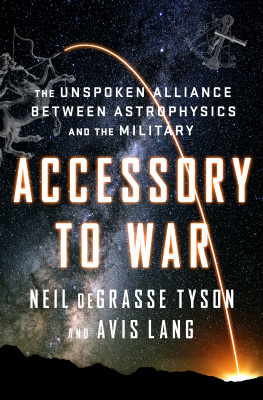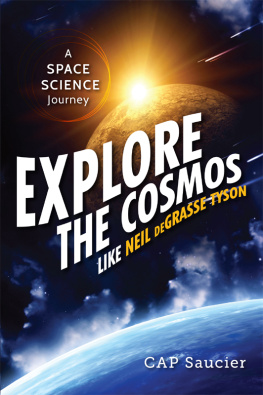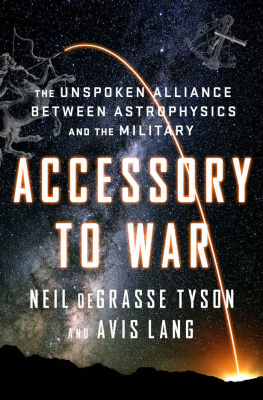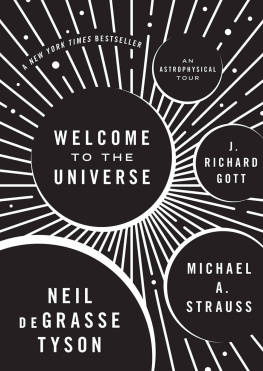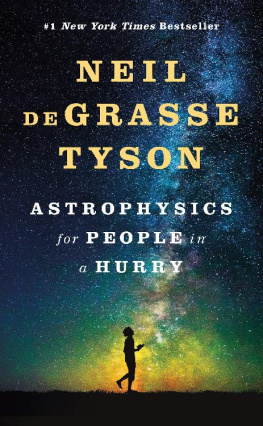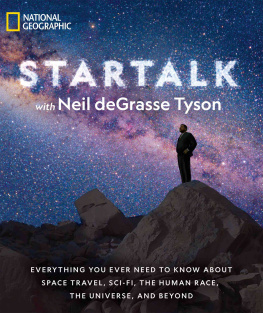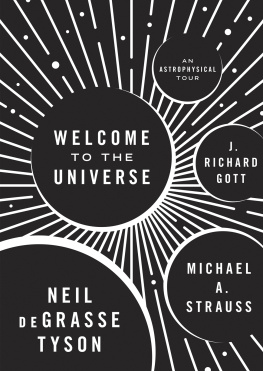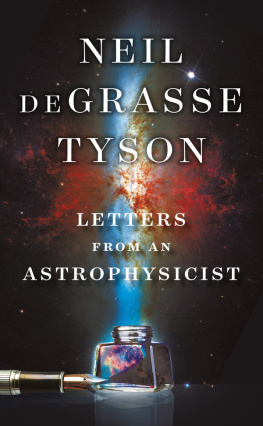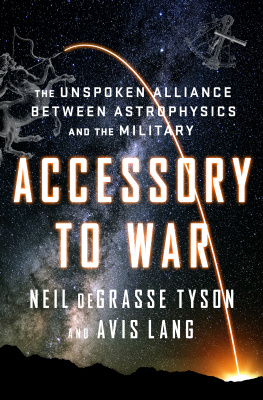
ALSO BY N EIL D E G RASSE T YSON
StarTalk: The Book
Welcome to the Universe: An Astrophysical Tour
(with Michael A. Strauss and J. Richard Gott III)
Cosmos: A SpaceTime Odyssey
HOST, NARRATOR, AND EXECUTIVE SCIENCE EDITOR:
13 -PART TELEVISION SERIES
The Inexplicable Universe
A 6 -PART VIDEO LECTURE SERIES
Space Chronicles: Facing the Ultimate Frontier
The Pluto Files: The Rise and Fall of Americas Favorite Planet
Death By Black Hole: And Other Cosmic Quandaries
Origins: Fourteen Billion Years of Cosmic Evolution
(with Donald Goldsmith)
My Favorite Universe
A 12 -PART VIDEO LECTURE SERIES
Cosmic Horizons: Astronomy at the Cutting Edge
(with Steven Soter, eds.)
The Sky Is Not the Limit: Adventures of an Urban Astrophysicist
One Universe: At Home in the Cosmos
(with Charles Liu and Robert Irion)
Just Visiting This Planet
Universe Down to Earth
Merlins Tour of the Universe
Astrophysics for People in a Hurry

N EIL DE G RASSE T YSON

Chapters adapted from Universe essays in Natural History magazine: April 2007.
Copyright 2017 by Neil deGrasse Tyson
All rights reserved
First Edition
For information about permission to reproduce selections from this book, write to Permissions, W. W. Norton & Company, Inc., 500 Fifth Avenue, New York, NY 10110
For information about special discounts for bulk purchases, please contact W. W. Norton Special Sales at specialsales@wwnorton.com or 800-233-4830
Book design by Chris Welch
Production manager: Anna Oler
JACKET DESIGN BY PETE GARCEAU
ART DIRECTION: INGSU LIU
JACKET IMAGES ISTOCK.COM
ISBN 978-0-393-60939-4
ISBN 978-0-393-60940-0 (e-book)
W. W. Norton & Company, Inc.,
500 Fifth Avenue, New York, NY 10110
www.wwnorton.com
W. W. Norton & Company Ltd.,
15 Carlisle Street, London W1D 3BS
For all those who are too busy to read fat books Yet nonetheless seek a conduit to the cosmos

CONTENTS
In recent years, no more than a week goes by without news of a cosmic discovery worthy of banner headlines. While media gatekeepers may have developed an interest in the universe, this rise in coverage likely comes from a genuine increase in the publics appetite for science. Evidence for this abounds, from hit television shows inspired or informed by science, to the success of science fiction films starring marquee actors, and brought to the screen by celebrated producers and directors. And lately, theatrical release biopics featuring important scientists have become a genre unto itself. Theres also widespread interest around the world in science festivals, science fiction conventions, and science documentaries for television.
The highest grossing film of all time is by a famous director who set his story on a planet orbiting a distant star. And it features a famous actress who plays an astrobiologist. While most branches of science have ascended in this era, the field of astrophysics persistently rises to the top. I think I know why. At one time or another every one of us has looked up at the night sky and wondered: What does it all mean? How does it all work? And, what is my place in the universe?
If youre too busy to absorb the cosmos via classes, textbooks, or documentaries, and you nonetheless seek a brief but meaningful introduction to the field, I offer you Astrophysics for People in a Hurry . In this slim volume, you will earn a foundational fluency in all the major ideas and discoveries that drive our modern understanding of the universe. If Ive succeeded, youll be culturally conversant in my field of expertise, and you just may be hungry for more.
The universe is under no obligation to make sense to you.
NDT
Astrophysics for People in a Hurry

The world has persisted many a long year, having once been set going in the appropriate motions. From these everything else follows.
LUCRETIUS, C. 50 BC
I n the beginning, nearly fourteen billion years ago, all the space and all the matter and all the energy of the known universe was contained in a volume less than one-trillionth the size of the period that ends this sentence.
Conditions were so hot, the basic forces of nature that collectively describe the universe were unified. Though still unknown how it came into existence, this sub-pinpoint-size cosmos could only expand. Rapidly. In what today we call the big bang.
Einsteins general theory of relativity, put forth in 1916, gives us our modern understanding of gravity, in which the presence of matter and energy curves the fabric of space and time surrounding it. In the 1920s, quantum mechanics would be discovered, providing our modern account of all that is small: molecules, atoms, and subatomic particles. But these two understandings of nature are formally incompatible with one another, which set physicists off on a race to blend the theory of the small with the theory of the large into a single coherent theory of quantum gravity. Although we havent yet reached the finish line, we know exactly where the high hurdles are. One of them is during the Planck era of the early universe. Thats the interval of time from t = 0 up to t = 1043 seconds (one ten-million-trillion-trillion-trillionths of a second) after the beginning, and before the universe grew to 1035 meters (one hundred billion trillion-trillionths of a meter) across. The German physicist Max Planck, after whom these unimaginably small quantities are named, introduced the idea of quantized energy in 1900 and is generally credited as the father of quantum mechanics.
The clash between gravity and quantum mechanics poses no practical problem for the contemporary universe. Astrophysicists apply the tenets and tools of general relativity and quantum mechanics to very different classes of problems. But in the beginning, during the Planck era, the large was small, and we suspect there must have been a kind of shotgun wedding between the two. Alas, the vows exchanged during that ceremony continue to elude us, and so no (known) laws of physics describe with any confidence the behavior of the universe over that time.
We nonetheless expect that by the end of the Planck era, gravity wriggled loose from the other, still unified forces of nature, achieving an independent identity nicely described by our current theories. As the universe aged through 1035 seconds it continued to expand, diluting all concentrations of energy, and what remained of the unified forces split into the electroweak and the strong nuclear forces. Later still, the electroweak force split into the electromagnetic and the weak nuclear forces, laying bare the four distinct forces we have come to know and love: with the weak force controlling radioactive decay, the strong force binding the atomic nucleus, the electromagnetic force binding molecules, and gravity binding bulk matter.

Next page
